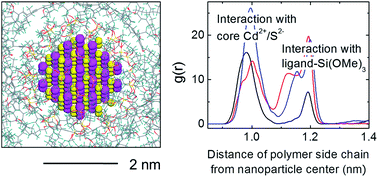Interaction of substituted poly(phenyleneethynylene)s with ligand-stabilized CdS nanoparticles†
Abstract
The interfacial region between surface-modified semiconducting nanoparticles and polymers remains difficult to characterize experimentally in atomic resolution and contributes to the limited efficiency of hybrid photovoltaic cells and luminescent devices. Therefore, molecular dynamics simulation was employed to investigate the structure of cadmium sulfide nanoparticles capped with 3-mercaptopropyltrimethoxysilane (MPS) in contact with four substituted poly(phenyleneethynylene)s using a new force field for CdS and the polymer consistent force field. The results show that polymers with long alkyl side chains tend to wrap around the nanoparticles, and reduce backbone bending as well as polymer diffusion. The absence of alkyl side chains decreases the distance of conjugated backbones from the surface. Differences in the preferred location of functional groups of the polymers on the nanoparticle surface and of covalent versus non-covalent bonding were also monitored. Polymers containing terminal hydroxyl groups on alkyl side chains approach the surfactant corona and the core of the CdS-MPS nanoparticles. Close contact supports the formation of silyl ether cross-links although the interfacial structure upon bond formation remains similar to that of the non-covalently attached polymers. Ester groups bound to aromatic rings in the poly(phenyleneethynylene) backbone did not closely approach the nanoparticle surface. The results are the first step to understand nanoparticle–polymer interfaces at length scales of 10 nm and explore correlations with photovoltaic performance.


 Please wait while we load your content...
Please wait while we load your content...